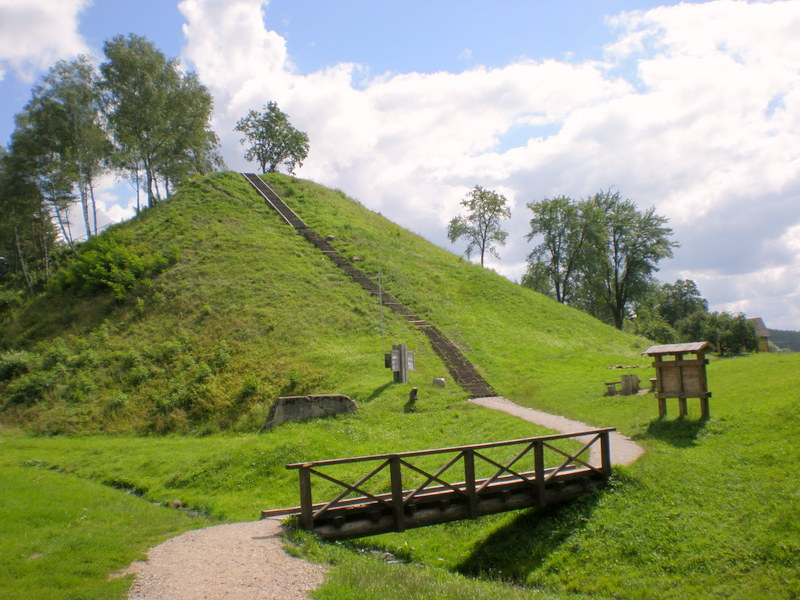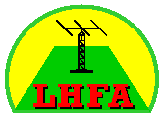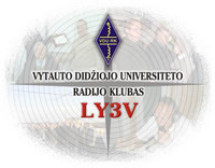MENU
LHFA sponsors
About program
- Details
- Category: LHFA
- Published on Saturday, 16 March 2013 18:21
- Written by Petras (LY2KM)
- Hits: 3869

Hill fort (castle hill) is a type of hill or mountain upon which a castle is standing or used to be standing, i.e. castle hill. Objects called as hill forts are usually very different in appearance and internal structure, ranging from the early hill forts mostly similar to regular hills to clearly visible trenches and mounds of fortified castle locations. The hill fort as a defensive structure is comprised of the following two main elements: the fortified location itself and its earthwork. It is considered that the Lithuanian name of hill fort (Lith. piliakalnis) was not derived from the word castle (Lith. pilis) but rather from the verb to pour (Lith. pilti). Most often the Lithuanian hill forts are naturally formed hills and capes with human-made earthworks of defensive purpose (mounds, steeps, terraces and ditches). A settlement was usually located near the castle and sometimes a fortified outwork was constructed.
Hill forts date back to 1000 years BC. They are the most important heritage of the pagan Baltic culture. The hill forts were not that predominant in other ethnic groups and nations, including
At first, fortified settlements used to be built on hill forts. Later on, in the 5th – 6th century they became shelters to people living at the base of the hill to hide away from attackers. In the beginning, the hill forts served their purpose by protecting people from the attacks of the local tribes and later – from the forces of the Teutonic Order, the Swedish and the Slavs. Ever since the 10th century people have started to reside on the hill forts and build wooden castles where the dukes lived. The hill forts stated losing their value at the end of the 14th century and the beginning of the 15th century. The hill forts in
Currently, hill forts are deemed archeological monuments protected by the State. They are included in the cultural heritage lists as places of interest and in the respective catalogues. The hill forts are cared for by the institutions responsible for protecting monuments. The present Lithuanian territory used to have over 1000 hill forts, 800 of which remained intact. Only about 10% of the hill forts were researched. Most of the hill forts are concentrated in the eastern part of
In 2005, the Ministry of National Defence of the
Contacts
- Details
- Category: LHFA
- Published on Saturday, 16 March 2013 08:55
- Written by Petras (LY2KM)
- Hits: 3387

|
Award manager LY2KM
This email address is being protected from spambots. You need JavaScript enabled to view it.
|
|
Web site administrator LY4K
This email address is being protected from spambots. You need JavaScript enabled to view it.
|
|
|
Hill-Forts in Google map
- Details
- Category: LHFA
- Published on Thursday, 07 March 2013 19:49
- Written by Augis (LY4K)
- Hits: 5677
![]() AL - Alytus region
AL - Alytus region ![]() SI - Šiauliai region
SI - Šiauliai region
![]() KA - Kaunas region
KA - Kaunas region ![]() TA - Tauragė region
TA - Tauragė region
![]() KL - Klaipėda region
KL - Klaipėda region ![]() TE - Telšiai region
TE - Telšiai region
![]() MA - Marijampolė region
MA - Marijampolė region ![]() UT - Utena region
UT - Utena region
![]() PA - Panevėžys region
PA - Panevėžys region ![]() VI - Vilnius region
VI - Vilnius region
|
LHFA Coordinate File download |
LHFA e-Log
- Details
- Category: LHFA
- Published on Saturday, 16 March 2013 08:46
- Written by Petras (LY2KM)
- Hits: 28394
Elektroninis žurnalas ( e-Log ) leidžia greitai pasitikrinti patvirtintus ryšius su Lietuvos piliakalniais.
Ryšiai, kurie yra bazėje, užskaitomi LHFA diplomams gauti. Tuo pačiu galite pasitikrinti ryšius diplomams pagal WAL ir LYFF programas. Tai universali QSO bazė, kurios autorius Saulius - LY1VP.
Suaktyvavus piliakalnį, logą ADIF formate prašome atsiusti adresu:
This email address is being protected from spambots. You need JavaScript enabled to view it.
Piliakalnių paieška qso bazėje - LHFA - Logsearch.
| Achievements of LHFA program participants |
| TA-39 |
LY5AT |
2024-04-13 |
| AL-33 | LY0NAS | 2024-03-15/16 |
LHFA Rules
- Details
- Category: LHFA
- Published on Monday, 04 March 2013 20:09
- Written by Petras (LY2KM)
- Hits: 5111
1. General Provisions
1.1. The Lithuanian Hill Forts Awards (hereinafter referred to as the LHFA) are designed for the purpose of spreading amateur radio activities and encouraging people to learn more about the Lithuanian history.
1.2. The LHFA awards shall be awarded for contact (observation) with the amateur radio stations from the hill forts located in the territory of the
1.3. The LHFA identification numbers shall be assigned to the hill forts by the Award Manager who also announces the hill fort list.
1.4. The hill fort list shall be updated no more than twice a year and shall be valid till the date of announcing the new list.
1.5. The hill fort identification number shall consist of two letters which are the abbreviations of the regions and the hill fort number, e.g. KL-01.
1.6. The following are the abbreviations of the regions used in the LHFA program:
AL – Alytus Region
KA –
KL –
MA – Marijampolė Region
PA – Panevėžys Region
SI – Šiauliai Region
TA – Tauragė Region
TE – Telšiai Region
UT – Utena Region
VI – Vilnius Region
2. Activation of hill-forts
2.1. Amateur radio station, activating hill-forts, during the establishing of QSOs:
- should not exceed the 100 meters distance to the top of hill-fort (according to hill-fort
coordinates, published in LHFA list) and must operate with portable call ... /p); - cannot be mobile (/m, /am, /mm);
- cannot use active repeaters.
2.2. The hill-fort is valid and counts for activator in case 30 different stations are worked during the activation. If operation is on 50 MHz and above, minimum requirement is 5 different correspondents. The necessary amount of QSOs can be collected during several activations.
2.3. There is no limit to power, type of modulation and frequencies used, but the activator must observe the requirements of his license. It is recommended to use as many as possible frequency bands in order to give an opportunity to score the hill-fort for foreign amateur radio stations.
2.4. Every radio amateur is obliged to honor and preserve nations cultural heritage,therefore during activation is forbidden to ride around hill-fort territory in unappropriated places, to litter, dig and destroy downhills or damage hill-forts in any other way.
3. Awards
The program includes the following awards:
LHFA - 50 for contacts with 50 different hill forts
LHFA - 100 for contacts with 100 different hill forts
LHFA - 150 for contacts with 150 different hill forts
LHFA - 200 for contacts with 200 different hill forts
LHFA - 250 for contacts with 250 different hill forts
LHFA - 300 for contacts with 300 different hill forts
LHFA - 350 for contacts with 350 different hill forts
LHFA - 400 for contacts with 400 different hill forts
LHFA - 450 for contacts with 450 different hill forts
LHFA - 500 for contacts with 500 different hill forts
LHFA - 550 for contacts with 550 different hill forts
LHFA - 600 for contacts with 600 different hill forts
LHFA - 650 for contacts with 650 different hill forts
LHFA - 700 for contacts with 700 different hill forts
LHFA - 750 for contacts with 750 different hill forts
LHFA - 800 for contacts with 800 different hill forts
LHFA - 850 for contacts with 850 different hill forts
LHFA - 900 for contacts with 900 different hill forts
LHFA TROPHY is awarded for contacts with all listed hill forts at the time of submitting the application.
LHF - ACTIVATOR for 25 activated different hill forts
For activated 50, 75, 100, 125, 150 and 175 different hill forts issued stickers.
The awards shall be given to the activators automatically, having complied with the necessary requirements. The activators shall submit a log in ADIF format so that the activation of the hill fort is duly recorded. This should be done within 10 days.
SWL awards are issued under analogous conditions. The higher level awards and the LHFA Trophy shall only be issued when the person already has the lower level awards. The LHFA awards and LHFA Trophy shall be awarded according to the applications of the amateur radio operators. The applications shall be prepared according to the radio station journal.
QSO since 01.June 2005 are valid.
As of 2010, all the contacts shall be confirmed by LHFA e-Log
The awards may be received in electronic copy, JPG or PDF format, free of charge.
LHFA TROPHY - plaquette.
Please submit your applications to the Award Manager at:
This email address is being protected from spambots. You need JavaScript enabled to view it.
4. Final Provisions
4.1. Each amateur radio operator respects and preserves the cultural heritage of the nation, thus, when activating the hill forts it is strictly prohibited to drive around in the territory of the hill fort in locations not intended for such use, litter, dig, destroy the slopes or damage the hill forts in any other way.
4.2. The Award Manager shall not be held liable for the actions of the hill fort activators.
4.3. The Award Manager retains the right to change and amend the LHFA program and his decision is final and inappellable.






